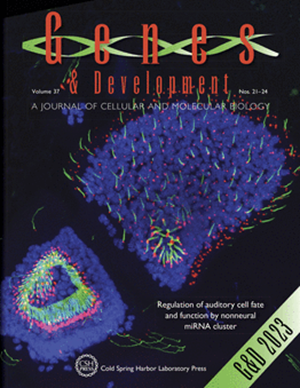跨TAD边界的旁观者激活支持增强子功能的内聚蛋白依赖转录簇模型
IF 7.7
1区 生物学
Q1 CELL BIOLOGY
引用次数: 0
摘要
哺乳动物的增强子可以在大的基因组距离上调节基因,通常会跳过其他基因。尽管如此,精确的发育调控表明存在确保增强子只激活其正确靶标的机制。三维染色体组织的雕刻通过黏结依赖环挤压被认为是重要的促进和限制增强剂的作用。拓扑相关结构域(TADs)的边界被认为可以阻止增强子作用于邻近TADs中的基因。然而,有例子表明增强子似乎跨越TAD边界起作用,但尚不清楚单个增强子是否可以同时激活不同TAD中的基因。本研究表明,一些Shh增强子不仅可以同时激活Shh位点的转录,还可以同时激活位于邻近TAD上的Mnx1位点的转录。这发生在染色质构象的背景下,维持基因和增强子的密切接近,并受到内聚蛋白的影响。据我们所知,这是首次报道两个内源性哺乳动物基因在同一增强子的控制下同时转录,并且跨越TAD边界。这些发现对理解基因调控景观的设计规则具有重要意义,并且与增强子-启动子通信的转录簇模型一致。本文章由计算机程序翻译,如有差异,请以英文原文为准。
Bystander activation across a TAD boundary supports a cohesin-dependent transcription cluster model for enhancer function
Mammalian enhancers can regulate genes over large genomic distances, often skipping over other genes. Despite this, precise developmental regulation suggests that mechanisms exist to ensure enhancers only activate their correct targets. Sculpting of three-dimensional chromosome organization through cohesin-dependent loop extrusion is thought to be important for facilitating and constraining enhancer action. The boundaries of topologically associating domains (TADs) are thought to prevent enhancers acting on genes in adjacent TADs. However, there are examples where enhancers appear to act across TAD boundaries, but it has remained unclear whether a single enhancer can simultaneously activate genes in different TADs. Here we show that some Shh enhancers can activate transcription concurrently not only at Shh but also at Mnx1 located in an adjacent TAD. This occurs in the context of a chromatin conformation maintaining genes and enhancers in close proximity and is influenced by cohesin. To our knowledge, this is the first report of two endogenous mammalian genes transcribed concurrently under the control of the same enhancer and across a TAD boundary. These findings have implications for understanding the design rules of gene regulatory landscapes and are consistent with a transcription cluster model of enhancer–promoter communication.
求助全文
通过发布文献求助,成功后即可免费获取论文全文。
去求助
来源期刊

Genes & development
生物-发育生物学
CiteScore
17.50
自引率
1.90%
发文量
71
审稿时长
3-6 weeks
期刊介绍:
Genes & Development is a research journal published in association with The Genetics Society. It publishes high-quality research papers in the areas of molecular biology, molecular genetics, and related fields. The journal features various research formats including Research papers, short Research Communications, and Resource/Methodology papers.
Genes & Development has gained recognition and is considered as one of the Top Five Research Journals in the field of Molecular Biology and Genetics. It has an impressive Impact Factor of 12.89. The journal is ranked #2 among Developmental Biology research journals, #5 in Genetics and Heredity, and is among the Top 20 in Cell Biology (according to ISI Journal Citation Reports®, 2021).
 求助内容:
求助内容: 应助结果提醒方式:
应助结果提醒方式:


